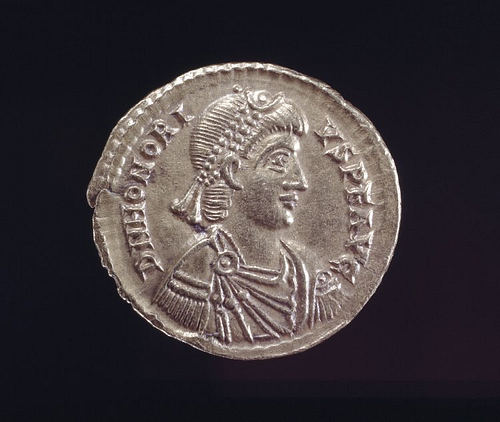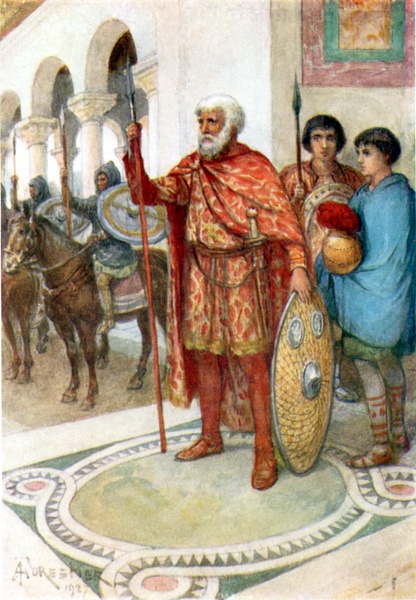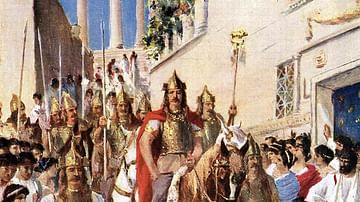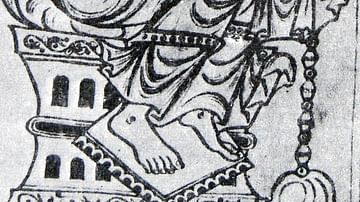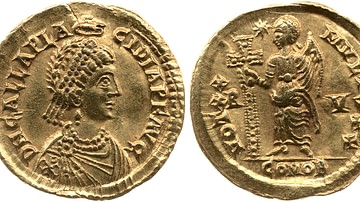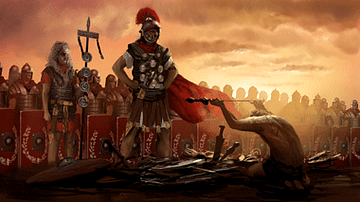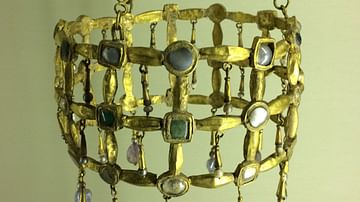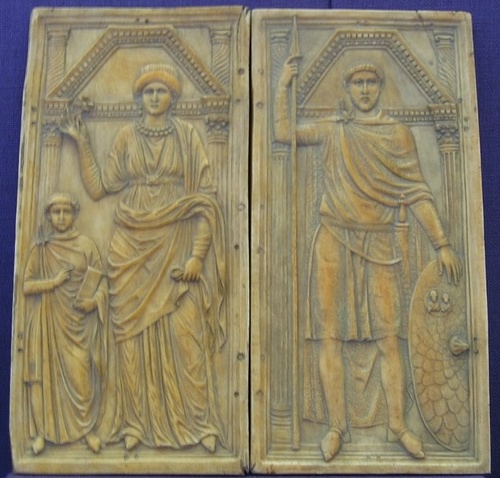
Flavius Stilicho (365-408 CE) was a Roman army commander, who rose in the ranks under the reign of Roman emperor Theodosius I (r. 378-395 CE) and eventually became the regent to his son Honorius (r. 395-423 CE). Stilicho fought with distinction in many military campaigns from Illyricum to Britain, however, his most famous opponent was Alaric, king of the Visigoths (r. 394-410 CE), whom Stilicho failed to defeat and whose Sack of Rome 410 CE would lead to the fall of the Western Roman Empire.
Early Career
Stilicho was born in 365 CE to a Roman mother and a Vandal father. Although little is known of his early life, like his father, an officer in the Roman army, he chose the military as a career. He rose quickly through the ranks and served with distinction under Emperor Theodosius I. In 383 CE, Stilicho served as an envoy to the Persian king Shapur III (r. 383-388 CE) to negotiate a peace settlement. Later, he commanded the emperor's household troops, and in 393 CE, he was promoted to chief of the army in the west (comes et magister utriusque militae praesentalis) - a position he would hold for the remainder of his life.
One year later, in 394 CE, war broke out between Theodosius and the usurper in the west, Emperor Eugenius (392-394 CE). At the Battle of the Frigidus, which ended with Theodosius' victory and Eugenius being beheaded, Stilicho fought alongside his future nemesis Alaric, the Visigoth. Like Stilicho, Alaric distinguished himself in the battle; however, to him, it appeared that his loyalty and bravery appeared had gone unrecognized and unappreciated. It was only a matter of time before he and Stilicho would meet again but on different sides of the battlefield.
However, in 395 CE, his career went in a completely different direction. Stilicho had already engrained himself into the royal family when he married Honorius' cousin, Serena, and according to his own account - there were no other witnesses - the emperor, lying on his deathbed, appointed him to be the guardian for both of his sons: Honorius (r. 395-423 CE) and Arcadius (r. 395-408 CE).
Regency
Theodosius was the last emperor to reign over a united empire. According to the emperor's wishes, Arcadius, who was 18 at the time, reigned in the east with Constantinople as his capital while Honorius was to rule in the west, however, since he was only ten (or twelve, according to some sources), he needed a regent. After the Battle of the Frigidus, Stilicho remained in control of the Roman armies both in the east and west, and one of Stilicho's long-term goals was to reunite the two halves of the empire under his control. However, his claim as guardian to Arcadius was challenged by the praetorian prefect Flavius Rufinus, who not only resented Stilicho's presence in Greece but the two men also disagreed over the treatment of the barbarians living there.
Two decades earlier, threatened by the Huns, the Goths had appealed to Rome for permission to cross the Danube and settle safely in Roman territory. Rome, believing their presence would bolster the area's defense, had agreed. Unfortunately for the Goths, unreasonable demands were made of these new settlers, they suffered at the hands of dishonest commanders, and they faced starvation due to inadequate provisions and a lengthy famine. The tension culminated in the Battle of Adrianople in 378 CE and ultimately led to a new treaty between the Goths and Romans in 382 CE, which allowed them to settle safely in the Balkans, but as allies, not citizens. However, the treaty required them to serve in the Roman army - something the Goths resented. Although the Goths were Christians, many in Rome were unhappy with the treaty and still viewed the Goths as nothing more than barbarians.
Nevertheless, their new king, Alaric, and his fellow Visigoths fought bravely alongside the Romans at the Frigidus, but they felt they had been maligned when promises had not been fulfilled. Although remaining loyal to Rome, Alaric believed that the Visigoths had been sacrificed unnecessarily, and he realized he had little choice but to take action, forcing Rome to fulfill their promises. As the animosity between east and west escalated, he moved his army eastward, ransacking cities southward into Greece. Rufinus contended that Alaric was acting on the directions of Stilicho. And, for good reason, as Stilicho always believed that Illyricum, rich in potential manpower, should have been part of the west. If a battle was in the making, he eyed the area as the eventual prize.
Seizing the opportunity to annex the area, he moved his army eastward to confront Alaric. Unfortunately, he would not meet Alaric in battle as planned. Obeying instructions from the young Emperor Arcadius, supposedly acting on Rufinus' orders, Stilicho withdrew to Italy and directed the Eastern troops to return to Constantinople. The returning troops, under the Gothic general Gainas, murdered Rufinus during a military review in 395 CE; some contend that Stilicho was behind the assassination.
Military Campaigns
In 401 CE, while Stilicho and his troops were involved on the northern frontier, Alaric and his army invaded Italy and threatened Milan where the young Honorius and his wife were living. The emperor was forced to escape to Asti in northwestern Italy. Stilicho brought his army from the Rhine frontier and Britain to protect Italy, leaving the north virtually unprotected. He met the Goths in battle at Pollentia in northern Italy, capturing Alaric's wife and forcing him to retreat. Alaric marched to Etruria in central Italy, but negotiations led to his complete withdrawal from Italy. However, Alaric would not remain away long and returned in 402 CE and attacked Verona in northeastern Italy. Alaric demanded grain and citizenship for his people, as well as an appointment for himself as magister militum in the Roman army. Refusing to meet the demands, the two met in battle, and Alaric was again forced to retreat, settling in Illyricum. Fearing a potential invasion, in 404 CE Honorius moved the capital from Milan to Ravenna, a city closer to the sea and protected by marshes.
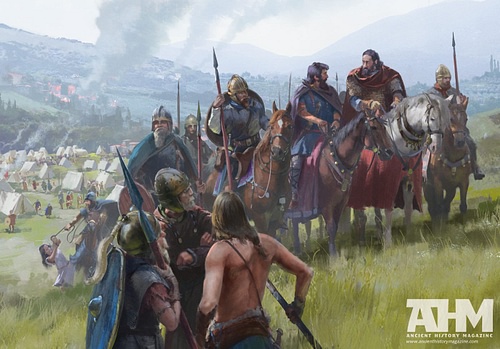
The on-and-off conflict with Alaric was not the only problem facing Stilicho. In the next few years, the empire was besieged by a number of invasions from the north. In 405 CE Italy was threatened by a tribe of Germanic Ostrogoths led by Radagaisus. An army estimated to be between 10,000 and 20,000 drove the Roman population off the frontier. Stilicho immediately responded by allying himself with King Uldin of the Huns and forced the Ostrogoths to retreat, and after cutting off their supplies, defeated them at Florentia. Part of the invading army was sold into slavery while others were ushered into the Roman army. Radagaisus was captured and executed in August of 406 CE.
Further problems emerged when Constantine, an ambitious Roman soldier, believed Roman Britain was being denied adequate protection and seized control of the island, crossed into Gaul and Spain, and established a base at Arles. Although an army under the Gothic commander Sarus was sent to oppose Constantine, the Roman attack failed, and Sarus was forced to retreat to Italy. With many of the Roman soldiers deserting to join him, the self-appointed emperor - eventually recognized as such by Honorius - would reign as co-emperor until his death in 411 CE. As Stilicho was involved with Radagaisus, Vandals, Alemanni, Alans, and Burgundians crossed a frozen Rhine River, and the Roman army was again forced to withdraw in order to forestall a possible invasion of Italy. With the lack of protection in northern Gaul, the presence of Constantine, and the invading Germanic tribes, the empire in the west was collapsing.
Downfall
Meanwhile, Stilicho revisited his dream of annexing Illyricum. His first order of business was to close the ports of Italy to all eastern ships. He appealed to his long-time nemesis Alaric for help. According to historian David Potter in his The Emperors of Rome, Stilicho had always believed Alaric was more useful alive than dead. He instructed Alaric to hold Epirus in northwestern Greece while he planned to cross the Adriatic Sea into Greece, but he had to abandon his plans after he heard rumors that Alaric was dead. Together with the news of Constantine's revolt in Gaul, Stilicho had no alternative. An angry and much alive Alaric kept waiting at Epirus, marched into Noricum, a province north of Italy, and demanded compensation of 4,000 pounds of gold for his troubles. Surprisingly, Stilicho was able to convince the Roman Senate to pay the demands. With a disgruntled Alaric on the rise and Constantine besieging Gaul, Stilicho's fate was sealed.
After Honorius' wife Maria, Stilicho's daughter who he had married in 398 CE and detested, died, he married Stilicho's second daughter Thermantia in 408 CE. Arcadius died the same year, and although rumors circulated that Stilicho had plans to go to Constantinople and put his son Eucherius on the eastern throne, Arcadius had been replaced by his 7-year-old son Theodosius II (r. 408-450 CE). Meanwhile, the army in the west was in complete disarray. Roman troops mutinied and killed several of Stilicho's generals. Realizing his fate was sealed, Stilicho went to Ravenna to surrender to the emperor and was promptly arrested. He was beheaded on 22 August 408 CE. His son's execution soon followed and so did many of Stilicho's commanders, mostly Germanic.
Some historians point to Stilicho's ambition and blame him in part for the fall of the Western Roman Empire. He failed to defeat Alaric and even allied with him. Stilicho was also criticized for filling his army with non-Romans, particularly remnants of the German invaders - something that angered many of the old Roman commanders. This shift in political and economic power left Rome weak and vulnerable. A frustrated Alaric would take his army to the doors of Rome, and in 410 CE, he left a weak and broken city.
